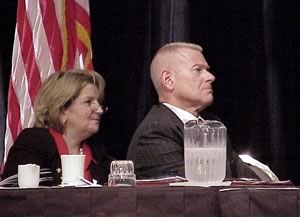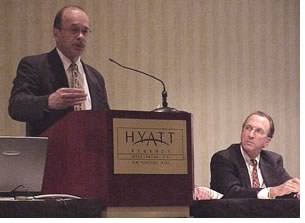

Security and Design Experts
Converge to
Share Lessons Learned

by Tracy
Ostroff
Associate Editor
“Transparent security”—design elements that protect life and property, but do not detract from the visual appearance of buildings—can help protect our nation’s infrastructure and reduce threats to the built environment, said building experts gathered September 14–15 in Washington, D.C. These practitioners pointed to reinforced and hardened buildings, increased setback distances, landscaping enhancements that give stand-off distances, efficient egress systems, and advanced air filtering systems as some of the ingredients of a recipe for a more secure America.

At the Second Annual Congress on Infrastructure for the Built Environment (ISBE), sponsored by The Infrastructure Security Partnership (TISP, an association of public and private-sector organizations of which the AIA is a part), experts spoke of implementing lessons learned from the September 2001 attacks on the World Trade Center and the Pentagon in their current work. Carl Galioto, AIA, partner, Skidmore, Owings & Merrill, said “distance is your best ally,” explaining how SOM is employing that principle at the new 7 World Trade Center by placing a park between the building and the sidewalk and restricting vehicular access accept for places where cars and trucks can be screened properly. The firm also designed an egress system with separate fire stairs wider than required by code to allows for flow and counter flow of inhabitants and emergency workers. SOM also is working toward a minimum silver U.S. Green Buildings Council LEED™ certification for the building.
 New
York City architect and panel moderator Barbara Nadel, FAIA, noted that
security consciousness has forever changed the way buildings are planned,
designed, budgeted, and built. Ed Feiner, FAIA, chief architect of the
U.S. General Services Administration, said his agency had its “baptism
of fire” with the bombing of the federal building in Oklahoma City
in 1995. The catastrophic event gave GSA five years prior to September
11, 2001, to learn about blast risk and research more secure ways to build
and retrofit federal facilities.
New
York City architect and panel moderator Barbara Nadel, FAIA, noted that
security consciousness has forever changed the way buildings are planned,
designed, budgeted, and built. Ed Feiner, FAIA, chief architect of the
U.S. General Services Administration, said his agency had its “baptism
of fire” with the bombing of the federal building in Oklahoma City
in 1995. The catastrophic event gave GSA five years prior to September
11, 2001, to learn about blast risk and research more secure ways to build
and retrofit federal facilities.
To make a positive and welcoming first impression with the public, the agency’s architects currently are separating superstructure areas from the entry lobbies, building with reinforced concrete, and creating stand-off distances through park-like environments, Feiner said. For example, he called the new U.S. Federal Courthouse in Miami—a new 16-story courthouse with 650 employees, 16 courtrooms, judge’s chambers, and detention cells—“a child of the 100-foot setback.” The area between the street and the building will be filled with a sculpture by Maya Lin, an element of the agency’s Art in Architecture program. The space will also house an arboretum, an extension of the Miami Botanical Garden.
Feiner also pointed to the success they have had in building extremely secure but approachable buildings, including the new federal building in Oklahoma City by Ross Barney Jankowski. The new U.S. Embassy to the United Nations in New York City is “meant to withstand as much as we can imagine.” The flip side to this reinforced idea of security, Feiner said, is that “there is a price to be paid” in terms of dollars and the public’s access to and perspective of their government. He also said we have to “get real” about certain issues. “We can solve everything [we can imagine to happen], but” he questioned, “do we have the money, need, and desire?”
 Security
consultant Bill Sewell agreed: “The level of security depends on
how much we want to spend.”
Security
consultant Bill Sewell agreed: “The level of security depends on
how much we want to spend.”
The panel, as well as other speakers at the event, agreed that some of the greatest threats to building security come from street-level bombs. Richard Tomasetti, cochair of the Thornton-Tomasetti Group, said building security can be manifested through three elements: building redundancy, building hardening, and stand-off distance. The appropriate solution is most probably the most cost-effective combination of the three, he said.
During a lunch on Thursday, Sen. Thad Cochran (R-Miss.), who serves as chair of the Subcommittee on Homeland Security, said he and his colleagues are working to fund the Department of Homeland Security adequately and assure that federal agencies have the information they need to protect our nation against terrorist attacks. “Everyone would like to spend more money, but we have to work within some limits,” he noted. He said additional funding would be targeted toward grant programs that fund first responders on the front lines in local jurisdictions. He also complemented TISP participants for coming together to discuss and seek remedies for the many challenges facing our nation’s infrastructure today and said he looked forward to continued communication with the allied organizations.
Plan for security as you would other disasters
Many participants agreed that requirements for natural disasters should
be as high or higher than those implemented out of concerns for terrorism.
Some participants said they thought new building codes should reflect
current concerns for building safety. If there is resistance to updating
national and local codes, participants opined, there should be an appendix
or other guidance issued for local authorities. One of the problems in
requiring the update of model codes is that different areas of the country
and various building types require disparate codes.
This point was evident on Thursday, as Beverly Prior, FAIA, of Beverly Prior Architects, San Francisco, and a member of the CAJ Advisory Group, led a discussion of federal officials through government design requirements and the current criteria for their agencies’ buildings. During the discussion, there was some tension between the U.S. Army Corps of Engineers and the GSA on the level of security each agency requires. The officials amicably said they are working out the differences, and that the dissimilar requirements stem from the building type and locations.
Video from the opening session and the federal design panel will be available soon. Check back with the AIA’s eClassroom for more details.
Copyright 2003 The American Institute of Architects.
All rights reserved. Home Page ![]()
